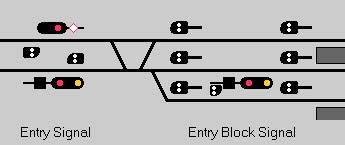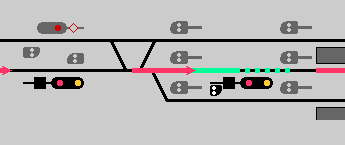Danish Signaling, Entry Block Signals
Draft
Updated 991111

Contents
Introduction
Entry Block Signal Types
Entry Block Signal Aspects and Indications
"Stop" (Danish: "Stop")
"Stop and
Proceed" (Danish: "Stop og Ryk Frem")
"Proceed at
reduced speed" (Danish: "Kør med begrænset hastighed")
"Proceed (at
high speed)" (Danish: "Kør (med høj hastighed)")
"Proceed Through"
(Danish: "Kør Igennem")
Entry Block Signal Usage
Entry Block
Signal Aspects Usage
Adding
a Station Block Section
Improving
Permitted Speed
Advance
Signaling an Entry Block Signal
Aspects
for Diverging Routes
Peculiarities
Entry Block Signal
with Reduced Speed Sign, Vanløse

Introduction
Entry Block Signals are station signals, designated by the
letters "SI", an abreviation of the Danish name Stationsbloksignaler
for Indkørsel. Entry Block Signals are located between the Entry
Signal and the normal "stopping location" on the station (i.e. the platforms):

The Entry Block Signal was introduced in the rulebook in 1953. The purpose
of the Entry Block Signal was to add an extra block in a long station throat,
in order to increase traffic capacity. The Entry Block Signal is typically
only added to the most heavily used tracks on the station, hence a train
entering a secondary track may not meet an Entry Block Signal on its way
to the platform. Entry Block Signals are located so that a train will at
most meet one Entry Block Signal in a station throat. There is, however,
a single location where an unusual routing of a train will bring it past
two Entry Block Signals.
Entry Block Signal Types
The Entry Block Signals are physically identical to Entry
Signals , though in much fewer variations. Entry Block Signal are generally
always supplemented by a Symbol
Speed Indicator except for a single installation
(Vanløse) .





It is common on larger stations to find Entry Block Signals with a Dwarf
Signal at its foot. This is due to the fact that Entry Block Signals have
no significance to switching moves. The Dwarf Signal, on the other hand,
has no real significance to trains. Both signals operate in main routes.
Entry Block Signal Aspects and Indications
The term Prescribed Speed as used
below is the speed prescribed in the Employee Timetable (Danish equivalent:
Tjenestekøreplanens Indledende Bemærkninger, TIB) or Track
Bulletins (Danish Equivalent: La).
Trains with active cab signals may receive
a more favorable indication than what lineside signals indicate. Cab signal
will govern in such cases.
"Stop" (Danish: "Stop")
"Stop and Proceed" (Danish: "Stop og Ryk Frem")
| |
 |
 |
 |
 |
-
Stop, then proceed to the end of the Entry Route
|
X |
X |
X |
X |
-
Maximum speed 40 km/h (25 mph)
|
X |
X |
X |
X |
-
Entry Route cannot be guaranteed to be unoccupied
|
X |
X |
X |
X |
-
Entry route is diverging in the direction of the upper lamp
|
|
|
|
X |
"Proceed at Reduced Speed" (Danish: "Kør
med begrænset hastighed")
| |
 |
 |
 |
-
Proceed on Entry Route at max. 40 km/h (25 mph)
|
X |
X |
X |
-
Stop at the station. Through trains may omit stopping if signals permit
them to proceed
|
X |
X |
X |
-
Entry route is diverging in the direction of the upper lamp
|
|
|
X |
|
|
X |
X |
X |
| |
 |
 |
 |
-
Proceed on Entry Route at max. 60 km/h (40 mph)
|
X |
X |
X |
-
Stop at the station. Through trains may omit stopping if signals permit
them to proceed
|
X |
X |
X |
-
Entry route is diverging in the direction of the upper lamp
|
|
|
X |
|
|
X |
X |
X |
| |
 |
 |
 |
-
Proceed on Entry Route at max. 40 km/h (25 mph). The Entry Route has no
safety overlap
|
X |
X |
X |
|
|
X |
X |
X |
-
Entry route is diverging in the direction of the upper lamp
|
|
|
X |
|
|
X |
X |
X |
"Proceed (at high speed)" (Danish: "Kør
(med høj hastighed)")
| |
 |
 |
|
|
X |
X |
-
Stop at the station. Through trains may omit stopping if signals allow
them to proceed
|
X |
X |
|
|
X |
X |
"Proceed Through" (Danish: "Kør Igennem")
| |
 |
 |
 |
-
Proceed through station at prescribed speed
Lowest permitted speed in the station entry end is 40 km/h (25 mph)
|
X |
X |
X |
-
Exit Signal shows "Proceed" or better. Any intermediate signals show "Proceed
Through"
|
X |
X |
X |
|
|
X |
X |
X |
-
Entry route is diverging in the direction of the upper lamp
|
|
|
X |
| |
 |
 |
 |
-
Proceed through station at prescribed speed
Lowest permitted speed in the station entry end is 60 km/h (40 mph)
|
X |
X |
X |
-
Exit Signal shows "Proceed" or better. Any intermediate signals show "Proceed
Through"
|
X |
X |
X |
|
|
X |
X |
X |
-
Entry route is diverging in the direction of the upper lamp
|
|
|
X |
| |
 |
 |
 |
-
Proceed through station at prescribed speed
Lowest permitted speed in the station entry end is 75 km/h (45 mph) or
higher
|
X |
X |
X |
-
Exit Signal shows "Proceed" or better. Any intermediate signals show "Proceed
Through"
|
X |
X |
X |
|
|
X |
X |
X |
-
Entry route is diverging in the direction of the upper lamp
|
|
|
X |
Entry Block Signal Usage
Entry Block Signal Aspects Usage
The Entry Block Signal
The Entry Block Signal aspects are similar to the aspects used in Entry
Signals , as an Entry Block Signal is basically an "Inner Entry Signal".
As briefly mentioned in the "Entry Block Signal Types"
section, an Entry Block Signal usually has a Dwarf Signal located at its
foot, to guide switching moves on the station. The Dwarf Signal acts as
if was an ordinary Dwarf Signal, except that in main routes the Dwarf Signal
will remain at "No Passing" until the Entry Block Signal clears to "Stop
and Proceed", "Proceed" or better:


In case the Entry Block Signal only displays "Stop and Proceed", the
Dwarf Signal will display "Pass with Caution" or "Pass", depending on the
state of the route immediately ahead:


In switching routes, the Entry Block Signal remains at "Stop":


Adding a Station Block Section
As mentioned before, the purpose of the Entry Block Signal is to break
up long station throats into two blocks. In the example below, the station
is fairly long due to a freight yard located before the platform tracks.
An Entry Block Signal is added on the approach to the inner "switch group",
and thus serves as an Entry Signal to the inner station segment:

The Entry Block Signal permits entering trains to enter the station
area without the route to the platforms necessarily being clear yet:

The normal entry route is via the Entry Block Signal:

But usually it is also possible to route the trains on a secondary route
bypassing the Entry Block Signal:

The definition of a "long" station is somewhat relative to the line
and the traffic pattern. In heavily trafficked commuter traffic, on line
segments with short blocks and low line speed, even a normal length station
is "long" relative to the surrounding block sections. In these cases an
Entry Block Signal may be located on the approach to the platform:

This "Platform Entry Signal" application of the Entry Block Signal permits
trains to approach an occupied platform very closely:

Improving Permitted Speed
A side effect of adding an Entry Block Signal is that the permitted speed
on entry to the station may be raised. This is true in situations where
speed is restricted in the inner part of the station. The train can now
be permitted to run at high speed to the Entry Block Signal instead of
having to run at reduced speed all the way from the Entry Signal. On lines
where the traffic intensity does not justify an Entry Block Signal, the
signal is sometimes added for speed improvement only:


Advance Signaling an Entry Block Signal
Adding an extra signal between the station Entry Signal and the platform
tracks presented a problem of how to advance signal the new signal. The
primary problem was how to let a train enter the station at high speed
but bring it to a stop before the normal stopping location in the platform
tracks. The solution to this problem was to add a new signal aspect to
the Entry Signal, permitting the train to enter the station at high speed
but warning that the Entry Block Signal might be showing "Stop" (or "Proceed"
at reduced speed)., The new aspect was implemented as a new symbol "Clear
to Entry Block Signal" (Danish: "Frit til SI") in the Symbol Speed Indicator:


The "Proceed at High Speed" aspect from the Entry Signal is only displayed
if the Entry Block Signal also shows this aspect. This way it still permitted
the train to proceed to the platform tracks at high speed, irrespective
of the presence of an Entry Block Signal.

An Entry Signal permitting entry at reduced speed only does not convey
information about an Entry Block Signal:




"Proceed Through" from an Entry Signal of course means that the Entry
Block Signal also shows "Proceed Through". The Speed Indicator on the Entry
Signal again provides the coarse advance signaling:




Aspects for Diverging Routes
In theory, the Entry Block Signal displays aspects for diverging entry
or through routes similarly to an Entry Signal. In reality, there happens
to be only one Entry Block Signal capable of displaying diverging aspects.
The Entry Block Signal in question is located at Vigerslev junction in
Copenhagen, and was previously the Entry Signal to the junction, before
the Airport Link was built.
The Vigerslev Entry Block Signal is in itself fairly straight-forward,
capable of displaying diverging aspects for "Proceed" as well as "Proceed
Through". The straight entry/through route permits a speed of 60 km/h while
the diverging is as low as 40 km/h:


Vigerslev breaks the otherwise very fixed rule that the "Proceed Through"
aspect from an Entry Signal is a unique route through the station, by having
the Entry Signal display the same aspect for both through routes. Since
both through routes only permit reduced speed, the required aspect on the
Entry Signal is the same. But from a strict point of view this is a violation
of the rules regarding entry routes, also considering that the permitted
speed on the two through routes is not the same.
Peculiarities
Entry Block Signal with Reduced Speed Sign, Vanløse
As part of temporary resignaling in conjunction with the Vanløse/Flintholm
reconstructions, the former Vanløse Entry Signal from Lersøen
was converted into an Entry Block Signal in late October 1999. In order
to minimize changes to the interlocking at Vanløse, the Entry Block
Signal has no symbol speed indicator, but instead a Reduced
Speed Sign:

The Entry Block Signal at Vanløse is only capable of showing
the "Stop" and the "Proceed at Reduced Speed" aspects:


Another peculiarity about the Entry Block Signal at Vanløse is
that the preceeding Entry Signal only has a Reduced Speed Sign, not the
otherwise mandatory Symbol Speed Indicator. The Entry Block Signal must
therefore be assumed to be at "Stop". As the case is, there is no through
route involving the Entry Block Signal:




![]()

































































![]()
![]()